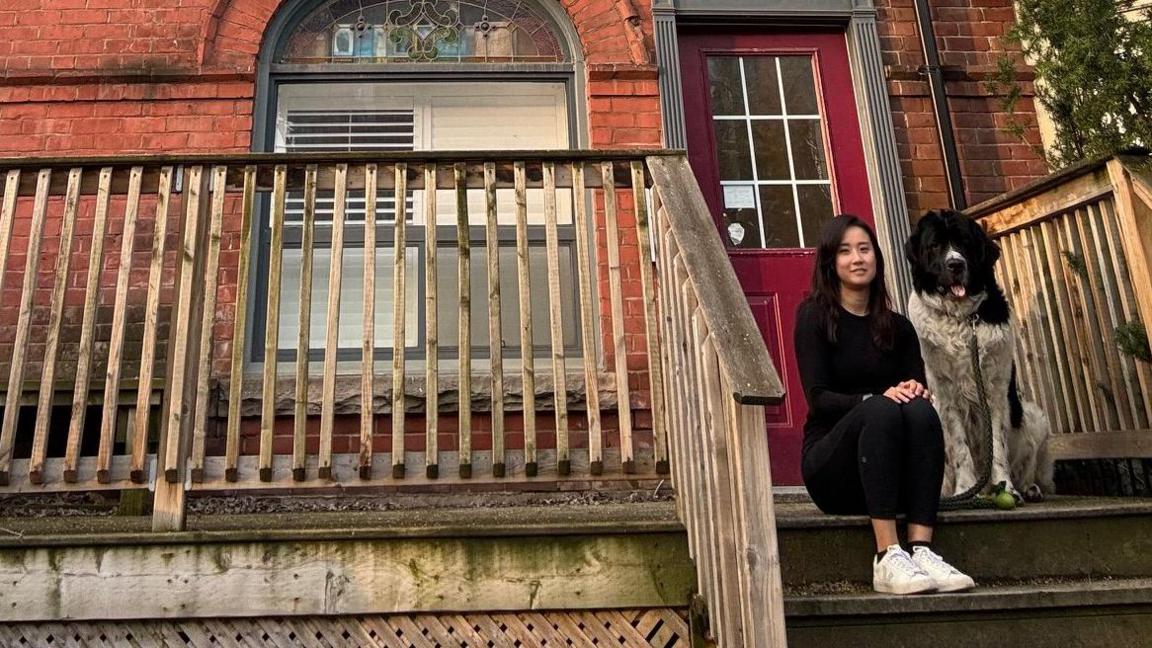Could a housing revolution transform Canadian cities?

Angela Jiang swapped living in a tall apartment tower for a converted fourplex
- Published
A new type of home called a fourplex is being hailed as the answer to Canada's acute housing shortage. But why is there so much opposition?
Angela Jiang says she is much happier since she moved out of a high-rise apartment building.
She used to live on the 68th floor of a condo tower in downtown Toronto, but five years ago she relocated to a four-unit residential building called a fourplex, in the city’s more low-rise midtown area.
Either a new-build, or the conversion of an existing single home, fourplexes are one building, typically detached, split into four separate apartments.
“I loved how the neighbourhood was more residential, how I didn’t need an elevator at all, and how the large balcony I had caught so much light,” says Ms Jiang, who works in investment banking.
Proponents of fourplexes, which include the Canadian government, hope they will spread out across the country. They want them to provide the “missing-middle” between large apartment buildings and single residency houses.
It comes as fourplexes made headlines this year in Canada after Prime Minister Justin Trudeau announced, external that the federal government would be making $CAN 6bn ($4.4bn; £3.4bn) in new money available to help provinces tackle the national housing crisis – a lack of affordable properties.
Federal Housing Minister Sean Fraser has required allowing fourplexes as a condition for municipalities to collect their share of this federal housing money.
This has been welcomed by some provinces, such as British Columbia (BC). The BC government has passed legislation to require fourplexes, and even five and sixplexes, to be permitted in any city with a population of more than 5,000.
Yet both the governments of Ontario and Alberta say they are opposed to municipalities in their provinces being forced to allow fourplexes. “We know that local municipalities know their communities best, and don't believe in forcing them to build where it doesn’t make sense,” Ontario Premier Doug Ford told the BBC.
This opposition centres on a fear that long-existing Canadian suburbs of single-family homes will have their character irretrievably changed if fourplexes are forced upon them.

Architects argue that fourplexes such as this new one in Toronto, need not be boring designs
While Toronto is now moving forward with fourplexes, its housing history is a useful guide to the issue. Put simply, new-build fourplexes were banned in the city from 1929 to 2023.
Instead, under previous zoning laws, large swaths of residential areas in Toronto were put aside for single-family occupancy detached and semi-detached houses.
It was a similar picture in other Anglophone Canadian cities. By contrast, in Montreal fourplexes and other small apartment buildings have always been more common.
“Toronto had specific regulations to defend single-family neighbourhoods,” explains Alex Bozikovic, author of House Divided: How the Missing Middle Will Solve Toronto's Affordability Crisis.
“There was classism at play here, as the 1910s saw policy that separated where homes and apartments could be built, as there was the perception that apartments bring the ‘wrong’ sorts of people into the neighbourhood, like immigrants.”
Mr Bozikovic adds that the situation is now changing thanks to the pressure from the federal government. “Minister Fraser is using funding and a bully pulpit to push municipalities to make necessary changes, because the government sees fourplexes as a palatable immediate solution to the affordable housing crisis,” he says.
“The questions for Canada become, ‘is this the answer?’, or ‘is this the only the first step to much larger reforms?’”

Toronto wants to diversify its housing stock away from apartment towers and single residency homes
But just because the Canadian government is pushing for more fourplexes doesn’t mean developers and architects will be seeking to build them.
“If you’re an experienced well-capitalized developer, there are strong incentives to do larger projects on the parcel of land you have,” says Brandon Donnelly, managing director of development at Toronto-based housing market investment firm Slate Asset Management. “Why spend time and resources to focus on a four-unit project when you can do a 150-unit project?”
Meanwhile, Canadian newspaper columnist Frances Bula wrote recently, external how financing fourplexes will also be challenging because banks are not used to them.
“Banks will need to develop a new kind of financing product to service this new missing-middle form of development, which is not the single-detached houses or concrete towers that banks have loaned money on for decades,” she says.
“And, in reality, ramping up large-scale production of fourplexes will likely require the growth of a new, niche type of developer.”

Tom Knezic says that fourplexes will be useful in creating more affordable homes
Tom Knezic, a Toronto architect and co-founder of Solares Architecture, designed one fourplex currently being rented in the city, and also designed four now under construction.
He says that there is a misconception that fourplexes have to be architecturally boring, and that instead architects can be creative with the layout and design. He adds, for example, that the four units can be vastly different in size, so one could be for a single person, and another for a family.
Mr Knezic says he hopes Toronto can also follow Vancouver’s “great model” and convert many large, single-family houses into separate apartments. “I think fourplexes can be one of the tools to make housing more affordable.”
Yet as appealing as fourplexes are to some, the boom hasn’t really taken off yet. As of last month, in both Toronto and Vancouver, only about 100 applications to build then had been received by authorities, according to press reports., external